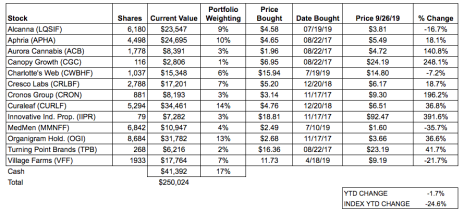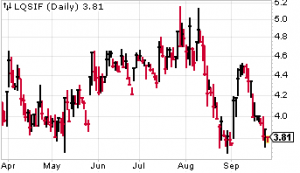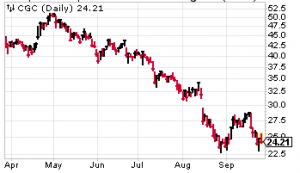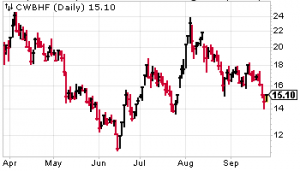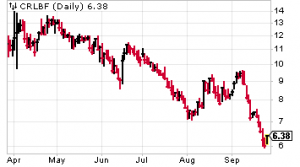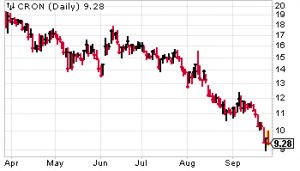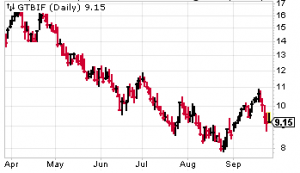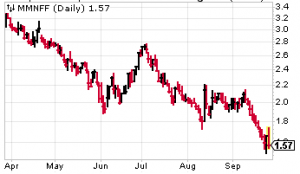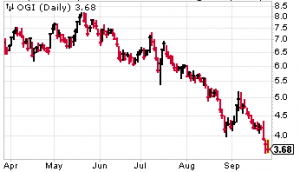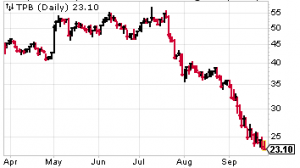The cannabis sector remains in a correction, weighed down in part by fears of vaping illness, but many stocks are doing considerably better than the sector and our challenge is to own the right ones—so that we can succeed both short-term and long-term.
Cabot Marijuana Investor 919
Lots of Crosscurrents!
The good news is that yesterday the U.S. House of Representatives voted in favor of the SAFE Banking Act (the acronym stands for “Secure and Fair Enforcement”), which would shield banks and other financial institutions from being held liable for serving marijuana businesses in states where the drug has been legalized. Backed by the American Bankers Association, the act would reduce the need to deal with cash, enable better tax collecting, and in general make the industry more efficient. The Senate, of course, still needs to approve the bill—or a compromise—and the near-term prospects there are uncertain. Still, it’s a great step in the right direction.
The bad news is that the marijuana sector is still in a major correction!
Marijuana Index
From its peak last October, when cannabis was legalized in Canada, until now, it’s down 55%—and of course many stocks have done worse!
Still, that’s the nature of investing in fast-growing young industries where regulations are evolving, valuations are high, trading volume is often thin and institutional sponsorship is light.
Interestingly, the broad stock market is quite healthy, with most indexes trading very close to all-time highs. Yes, there’s been some serious rotation recently, with leadership shifting, but weakness such as we’ve seen in the cannabis sector has been rather rare.
Early on, this sector weakness could be attributed to the natural tendency of hot sectors to go cold; cannabis stocks were red-hot from January through March, so they needed a good correction. But more recently, the rise of vaping illnesses has weighed further on the sector, as “fear of the unknown,” a classic bugaboo for stocks, has permeated the group.
Nevertheless, I remain confident that the sector will rebound and zoom higher once again; these companies are simply growing too fast for their stocks to be held down too long. And as efforts to make the cannabis industry increasingly legal spread, I have no doubt that the leading multi-state operators (MSOs) in the U.S. and the leading companies in Canada will see their footprints grow, and their revenues and earnings follow suit.
Investing Strategy
Our strategy is twofold.
One, we want to own the stocks that are likely to be the leaders of this industry five and ten years from now, because long-term investing is where the big money is made. Two, we want to make money in the short term, by overweighting our investments in strong stocks and underweighting our investments in stocks that are weak—and holding cash when appropriate.
Sometimes this means selling at peaks and taking short-term profits—which can be fun. And sometimes it means selling and taking short-term losses—which is never fun. But one of the cardinal rules of growth stock investing is that you must cut losses short, so that you can have cash to redeploy into stronger stocks. A corollary of this is that we never average down; instead we average up, rewarding success. Basically, you want to lose small and win big.
Additionally, diversification is mandatory. Any one stock can go wrong; but if you invest in enough of these cannabis stocks, the long-term trend of the industry is guaranteed to reward you. Early on, we were more heavily invested in the Canadian producers, but as the U.S. MSOs have grown, we’ve been leaning more that way, because in the long run, U.S. companies will serve a larger market.
Lastly, a note to our newer readers. You’ve arrived at what is probably a great time to invest in the industry—but don’t be in a hurry to jump in. Study the charts, understand what you’re buying, and take it slow, working to build a diversified portfolio over time.
WHAT TO DO NOW
Going into today, the portfolio is 17% in cash, 83% invested, and most heavily invested in Aphria (APHA) Curaleaf (CURLF), and OrganiGram (OGI), three companies that are already profitable (or soon will be) and that look like long-term winners. For this week’s adjustments, we will sell our poorest performer, MedMen (MMNFF), and add a 5% position in Green Thumb Industries (GTBIF), the net result of which will be a slight reduction in cash.
CURRENT RECOMMENDATIONS
Alcanna (LQSIF)
Thinly traded Alcanna, which is diversifying from the slow-growth retail alcohol industry in Canada to the fast-growth cannabis industry, saw its stock bottom in the 3.7 area in May and August and once again on Wednesday. If the stock can hold up here, we’ll stick with it, but if not, we’ll let it go. The stock is cheap compared to everything else in the portfolio, but that’s mainly because of the anchor (albatross?) of its alcohol business.
Aphria (APHA)
Aphria, currently the largest producer in Canada, bottomed at 5 on the first day of August, hit 7.6 three trading days later, and has now nearly completed a round trip. Fundamentally, prospects are bright at the company—analysts expect EPS of $0.03 per share in 2020 and $0.24 in 2021—and if the stock can establish a bottom at or above 5, buying is recommended.
Aurora Cannabis (ACB)
Aurora was the second largest Canadian producer in the second quarter, but the stock has been trending down since March, and it’s still expensive! The portfolio has been underweight for many months, and will continue to hold, as the stock is nearing an area of long-term support
Canopy Growth (CGC)
Canopy used to be the #1 Canadian cannabis producer; now it’s third. Its stock traded at 52 in April; now it’s less than half that. And CGC is still expensive, with a market capitalization of 29 times trailing revenues. Still, Constellation Brands, which owns 38% of the company, is expected to have some influence when cannabis drinks go on the market in Canada in December—though positive earnings aren’t expected until 2022. The stock is currently at support, trying to build a bottom. And the portfolio is severely underweight.
Charlotte’s Web (CWBHF)
Colorado-based Charlotte’s Web is America’s biggest seller of CBD, whose products are sold at over 8,000 retail locations, and last week the company announced that 738 locations of The Vitamin Shoppe (VSI) would be added to the list. Charlotte’s Web has operated at a profit for years, and analysts are expecting EPS of $0.19 in 2019 and $0.69 in 2020. As for the chart, after an explosive eight-day run, it peaked at 24 in August (the portfolio sold half its position at 23.5), and after a normal pullback, built a nice base between 15 and 18—during which the portfolio averaged back in at 17. But now the sector and market weakness has caused the stock to roll over for another leg down. If you haven’t bought yet, wait for a bottom to be established.
Cresco Labs (CRLBF)
Last week I wrote, “The third-largest MSO in the U.S., Cresco has probably just completed its correction, bottoming at 7 in early August and then again this Monday.” Wrong. The stock has fallen below that support level and now there’s no knowing where it will stop—although there’s a case to be made for the 6.0 level. Long-term, the company has fine prospects; revenues in the latest quarter were $29.9 million, up 253% from the year before, and analysts are expecting EPS of $0.23 in 2020. But one of the cardinal rules of investing is not to let a big winner turn into a loss, and given that the portfolio got in at 5.20, I’m going to keep a close eye on this (although I can’t forget that we took profits out at 9.0 and 11.1).
Cronos Group (CRON)
Fundamentally and financially, Cronos seems to have a lot going for it. Altria owns 45% of the company, and analysts are expecting EPS of $0.84 in 2019 (though then a swing to a loss of a penny in 2020). But volume-wise, the company is off to a slow start, with its $10.2 million in second quarter revenues putting it in sixth place among Canadian producers. Even worse, the stock continues to cool off from its overheated state after the Altria investment, this week touching lows it hadn’t seen since December. The portfolio has taken profits and still has a big profit and is underweight, so can afford to sit patiently, but if you don’t own it, look elsewhere.
Curaleaf Holdings (CURLF)
Curaleaf is the largest position in our portfolio, as well as the leading MSO in the U.S., with second quarter revenues of $48.5 million, up 219% from the year before. Once the acquisition of Grassroots (operating in Illinois, Ohio and Pennsylvania) is complete, the company will be operating in 19 states. And it’s turning the corner financially, with analysts looking for a one cent loss per share this year and then a profit of $0.17 per share in 2020. As for the stock, it was the strongest in the portfolio last week (which isn’t saying much), but sellers pushed the stock back down this week, and now the stock has what optimistically looks like a reverse head-and-shoulders pattern, which frequently precedes major uptrends. If you haven’t bought yet, you can buy here.
Green Thumb Industries (GTBIF)
This Chicago-based MSO has 13 manufacturing facilities, licenses for 95 retail locations and operations across 12 U.S. markets. Second quarter revenues were $44.7 million, up 228% from year before, and analysts are looking for a loss of $0.19 per share this year and then a profit of $0.08 per share in 2020. The stock bottomed in August at 8, peaked last week at 11, and is now on a normal pullback, which looks like a decent entry point. We sold for a loss in July, but the development of this bottoming formation looks like a good time to get back in. The portfolio will take a 5% position.
Innovative Industrial Properties (IIPR)
IIPR is the REIT whose stock kept on going up and up even after most marijuana stocks rolled over in April; the stock didn’t peak until July! After that it went into a well-deserved correction, finally bottoming right at its 200-day moving average three weeks ago, and since then it’s bounced normally, but technical analysis says it likely needs time to build a base before resuming its uptrend. Fundamentally, all seems well here; as of September 12, the company owned 30 properties in Arizona, California, Colorado, Illinois, Maryland, Massachusetts, Michigan, Minnesota, New York, Nevada, Ohio and Pennsylvania, totaling approximately 2.2 million rentable square feet, which were 100% leased. The company’s average current yield on invested capital is approximately 14.5% for these 30 properties. And analysts are projecting EPS of $2.79 in 2019 (up 115% from the year before) and then $4.80 in 2020, up 65%. Indeed, the firm recently announced a 78 cent per share dividend for the current quarter, up 30% from the prior quarter! The one big unknown in my mind is what effect legal cannabis banking will have on the company; will customers find alternative sources of funding and will other REITs muscle in? As always, the answer to that will be told by the chart.
MedMen (MMNFF)
MedMen is the portfolio’s biggest loser and today it gets kicked out. With analysts projecting a loss of $0.40 this year and a loss of $0.16 next year, this MSO is losing ground to better-managed, better-funded competitors. Sell.
Organigram (OGI)
OrganiGram is the portfolio’s biggest Canadian position, partly because we’ve done well buying low and selling high and partly because the financial prospects for the company are good; analysts are expecting a profit of $0.06 per share in 2019 and $0.16 in 2020. Trouble is, in recent weeks, the stock has continued to fall. Stepping back and looking at the weekly chart, we can still say the stock is in an uptrend, but it needs to bottom at or above 3.0.
Turning Point Brands (TPB)
When investing in hot new sectors like cannabis, stratospheric valuations are common; even today, after this big correction, Canopy sells for 29 times trailing revenues. But TPB is actually a good value by traditional measures! With analysts looking for EPS of $2.06 this year (up 13%) and $2.54 next year (up 23%), the stock’s forward PE ratio is just 12. Trouble is, Turning Point’s major pivot into the cannabis industry was in the vaping segment, and that’s currently under serious pressure. The portfolio is underweight and waiting to see how far this extended trend can run.
Village Farms International (VFF)
Village Farms International is the Canadian greenhouse grower of tomatoes, cucumbers and peppers that’s diversifying into marijuana (in Canada) and hemp (in the U.S.). Like Turning Point, this stock has gotten to be a decent value. Analysts are looking for EPS of $0.70 this year and $0.91 next year (up 30%), so the forward PE ratio is just 13. If you haven’t bought yet, you can buy on this pullback.
WATCH LIST
Grow Generation (GRWG) is the largest hydroponic equipment supplier in the U.S., with 25 distribution and retail locations across 9 states and it’s growing by acquisition, having acquired six stores this year. Second quarter revenues were $19.5 million, up 172% from the year before, and EPS was $0.20 per share. Additionally, the company appointed Bob Nardelli, former CEO of Home Depot, as Senior Strategic Advisor. The chart peaked at the end of August and is now on a normal correction.
The next Cabot Marijuana Investor issue will be published on October 31, 2019.
Cabot Wealth Network
Publishing independent investment advice since 1970.
CEO & Chief Investment Strategist: Timothy Lutts
President & Publisher: Ed Coburn
176 North Street, PO Box 2049, Salem, MA 01970 USA
800-326-8826 | support@cabotwealth.com | CabotWealth.com
Copyright © 2019. All rights reserved. Copying or electronic transmission of this information is a violation of copyright law. For the protection of our subscribers, copyright violations will result in immediate termination of all subscriptions without refund. No Conflicts: Cabot Wealth Network exists to serve you, our readers. We derive 100% of our revenue, or close to it, from selling subscriptions to its publications. Neither Cabot Wealth Network nor our employees are compensated in any way by the companies whose stocks we recommend or providers of associated financial services. Disclaimer: Sources of information are believed to be reliable but they are not guaranteed to be complete or error-free. Recommendations, opinions or suggestions are given with the understanding that subscribers acting on information assume all risks involved. Buy/Sell Recommendations: All recommendations are made in regular issues or email alerts or updates and posted on the private subscriber web page. Performance: The performance of this portfolio is determined using the midpoint of the high and low on the day following the recommendation. Cabot’s policy is to sell any stock that shows a loss of 20% in a bull market or 15% in a bear market from the original purchase price, calculated using the current closing price. Subscribers should apply loss limits based on their own personal purchase prices.



